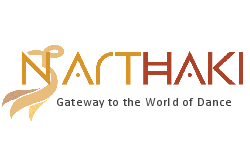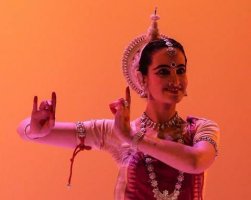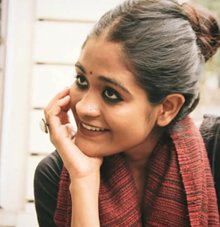
|
 |

|
 |
The use of Mudras in Odissi dance: A symbolic language of expression and spirituality- Sunandini Dase-mail: dsunandini0804@gmail.com June 27, 2025 Abstract This research paper explores the ancient classical dance form of Odissi, originating from the Indian state of Odisha, emphasizing its historical and cultural significance. It highlights the connection between Odissi and religious traditions. The study delves into the role of mudras (hand gestures) in conveying stories and emotions, connecting Odissi to Hinduism and Buddhism. The paper showcases how these dance traditions have persisted over the years, evolving while staying rooted in the language of symbols. It sheds light on the rich cultural tapestry that Odissi dance continues to represent. The Use of Mudras in Odissi dance: A symbolic language of expression and spirituality Odissi, a traditional dance style originating from the eastern Indian state of Odisha, is globally renowned for its graceful movements, sensuous expressions, and its deep connection to devotion and surrender, known as "bhakti bhava." Odissi enthusiasts and scholars argue that it is the most ancient among India's classical dance forms, with its roots in temple performances in Odisha. They support this assertion with various forms of evidence, including architectural and textual sources, as well as ongoing ritual practices. Odissi dancers frequently cite the Natyashastra, a foundational text for Indian performing arts, which mentions an early dance style known as Odra Magadhi, considered by many experts as a precursor to the 20th century Odissi dance form. Supporting these claims are the archaeological findings uncovered in and around Bhubaneswar. Jain cave temples of Udayagiri and Khandagiri (near Bhubaneswar), Ranigumpha cave (Cave of the Queen) in Udayagiri, Hathigumpha cave (Elephant cave), also in Udayagiri, they all have scenes of dance and music carved on them which date back to the second century BC. In the existing historical literature on Odissi, there's a noticeable gap in terms of archaeological evidence from the time following the Udayagiri and Khandagiri period until we resume the historical narrative in the 6th century AD. During this later period, the rulers of Odisha began to extensively support temple construction. Bhubaneswar saw the construction of numerous temples between the 6th and 13th centuries AD. Notable examples include the 12th-century Jagannatha temple in Puri, commissioned by the Ganga King Anantavarman Chodagangadeva, and the 13thcentury Konark temple built by Narasingha Deva I. These temples serve as reflections of the diverse religious practices that thrived in ancient and early medieval Odisha, encompassing Buddhism, Jainism, Shaivism, Vaishnavism, Shakti worship, and the Bhakti movement. The architectural remnants in the region provide evidence of these varied and coexisting belief systems. Up until the mid-twentieth century, one of the various forms of religious devotion practiced within Odishan temples, notably the Puri Jagannath temple, included the ceremonial performance of singing and dancing by maharis. The term "mahari" was often used interchangeably with "devadasi," which denotes a female devoted to serving a deity or temple. According to mythology, Shiva imparted the art of dance and performance to Nandikeshvara, a prominent theorist of Indian music and dance, who authored the Abhinaya Darpana. Nataraja's dance is known as tandava and sometimes regarded as a masculine form of dance. Nandikeshvara passed on this knowledge to Brahma, who then entrusted Bharata with the task of composing the Natyashastra. According to the Natyashastra, Brahma is identified as the origin of natya (dance-theatre), Vishnu is the source of vritti (the fundamental elements of drama), and Nataraja is recognized as the origin of nritya (dance). In Sanskrit, the essence of the term "mudra" (gesture) is encapsulated by the phrase "mudam anandang rati dadati," signifying "that which bestows supreme delight." According to the Natyashastra, 'the experts are to use the mudras according to the popular practice and in this matter, they should have an eye on their movement, objects, sphere, quantity, appropriateness and mode' (Bharata 1995). The palm of the hand serves as a central point for expressing emotions. Displaying the palm with various finger positions is a hallmark of classical dance. The wrist acts as the pivotal point for directing hand movements in different directions. The language of mudra is rooted in 24 mudras as detailed in the Natyashastra and 28 in the Abhinaya Darpana. Single-handed gestures are referred to as "asamyukta," while those involving both hands are termed "samyukta." 'Various gestures of the hand that express human emotions or depict objects are known as mudras. The dance artistes embody their 'bhavas' or feelings with the help of these tutored gestures. In short, mudras constitute the language or vocabulary of dance (Devi 1972:43).' Particularly here, I'm going to talk about a few mudras from Odissi hasta mudras and how they convey religious symbolism. Mudras in Hinduism  Anjali mudra  Trishula mudra Anjali mudra: As we know the meaning of the word Anjali in Sanskrit is "divine offering", this mudra is a gesture of devotion and respectful greeting in which both hands are clasped together with the fingers upwards and palm touching. It is held near the chest. Devotees and minor deities are often portrayed in this pose. Trishula mudra: Trishula is a trident or a spear with three points and is depicted by holding up the first three fingers. In Odissi dance it is used to depict Lord Shiva and his trishul. Mudras in Buddhism Shankha mudra: This mudra is used by devotees during the depiction of offering their devotion to the lord. The shankha is one of the eight auspicious symbols of Buddhism, the Ashtamangala, and represents the pervasive sound of Buddhism.  Shanka mudra  Benu Hasta mudra Bhumisparsha mudra: This mudra depicts touching the earth and is often used to represent the moment of enlightenment when Buddha touched the earth to bear witness to his realization. The hand is extended downward with the fingers touching the ground. Most of the dance items of Odissi including abhinaya and nritya depict mythological stories and through the amalgamation of the mudras, different gods and goddesses are depicted. For examples, through my years of training in Odissi, I'm going to list down a few mudras and which mythological characters they depict. 1. Lord Krishna: Benu Hasta mudra depicts Lord Krishna's flute and Mayura hasta mudra depicts the peacock feathers he wears on his head 2. Lord Shiva: Trishula hasta mudra, resembles his trishul, Sarpashishy hasta mudra resembles his bahon, snake, Mushthi hasta mudra and Hamsasya hasta mudra resembles his jata. 3. Lord Vishnu: Lord Vishnu is depicted using Suchi hasta mudra resembling his chakra, Shankha hasta mudra resembling his shankha. 4. Lord Ganesh: Lord Ganesh is depicted using Kapitha hasta mudra, his ears are depicted with Pataka hasta mudra, trunk is depicted with Hamsapaksha hasta mudra. Through the above discussion, we come to this conclusion that Odissi dance has many connections with different religious beliefs such as Hinduism, Buddhism, Jainism and Shaivism. The dance form that comes directly from the temples of Odisha, the sculptures that were carved showing different postures like Tribhanga and Chouka and using different Hasta Mudras depicting and narrating mythological stories come live on stage in this contemporary world today. Though the original and the primary choreographies have mostly now have gone through lots of change by different interpretations and improvisations of many Gurus, dancers and choreographers, still, the basic grammar remains the same and trails back to those temple carvings. What ties Odissi dancers all around the world are the hasta mudras, which are used to depict various items and bhavas, in the same language, the language of symbols. References: 1. Nayak, S. (2020) Odissi: An Understanding of the Neo-Classical Aesthetics 2. Dasgupta, S.L. (2018) Mudra: Various Aspects and Dimensions 3. Rajput, S.A (2016) The Source, Meanings and Use Of "Mudra" Across Religions 4. Pathloth, V (2018) Critical Analysis of Hasta Mudra and Their Interpretations in Dance  Sunandini Das, a graduate student of Sociology from Presidency University, Kolkata, is also an Odissi dancer with a keen interest in dance research and its relevance in the field of sociology. Post your comments Pl provide your name and email id along with your comment. All appropriate comments posted with name & email id in the blog will also be featured in the site. |